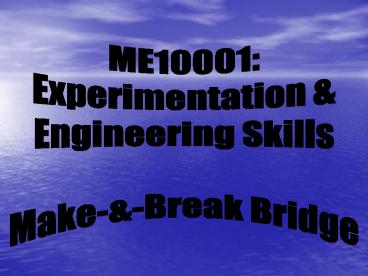ME10001: - PowerPoint PPT Presentation
1 / 14
Title:
ME10001:
Description:
It was designed to be minimum cost, using the least amount of wood and glue (no paper was used) ... for the arch ends to use as buffer in case of glue failure. ... – PowerPoint PPT presentation
Number of Views:29
Avg rating:3.0/5.0
Title: ME10001:
1
ME10001 Experimentation Engineering
Skills Make--Break Bridge
2
- OBJECTIVES
- To design, construct and test to destruction a
minimum cost balsa wood bridge. - It must withstand a load of 50N, dead-centre
applied from above. - It must span a gap of 0.5m.
- It must have a maximum deflection not exceeding
20mm.
3
- MATERIALS COSTINGS
- Lengths of 6mm x 6mm balsa wood strips.
- Paper.
- Balsa cement glue.
- Balsa wood - 10 per 100mm3.
- Paper - 1 per 100mm2.
- Balsa Cement glue - 10 per mm3.
4
- CONSTRUCTION PROCESS
- It was designed to be minimum cost, using the
least amount of wood and glue (no paper was
used). - Triangulated structure was considered but arching
was less expensive (less glue and wood), so
arching was used instead. - Crossed arches were used to prevent twisting and
to increase the rigidity and strength of the
overall structure. - Arches designed to take load at the end load
points. - A vertical support dead-centre was used to add
some strength to the arches and allow the bottom
frame to take some loading.
5
- PROBLEMS ENCOUNTERED
- Securing the balsa wood arches was difficult, and
so stoppers and grooves were needed. The stoppers
also aided horizontal loading. - It was found that the balsa wood varied in
twisting, bending and hardness. Some lengths were
soft and bent a lot more than other lengths.
Therefore, the stiffer stronger lengths were
chosen (also increasing the need for stoppers and
grooves). - As some lengths bent more than others, 2 similar
pieces had to be chosen. This also meant that the
degree of curvature was limited to how much the
wood could bend before breaking. An angle of 22o
was made between arch and horizontal support.
6
FINAL STRUCTURE DIMENSIONS The arches are
650mm long each.
35mm
100mm
600mm
This is the groove support that was used to help
ensure that the arches did not come unstuck.
There was another support for the arch ends to
use as buffer in case of glue failure.
7
COST OF BRIDGE 2 x 600mm 2 x 650mm 6 x 100mm
Balsa wood 11,646 1 x 100mm 1 x
35mm 500mm2 Glue 5,000 Overall
Price 16,646
8
TESTING
9
TESTING
10
GRAPH Force (N) against Extension (mm)
11
- GRAPH
- The deflection of the bridge was not greater than
20mm, which achieved the objective. - The maximum load that the bridge took was 37N,
failing the objective. - At point X the gradient of the curve increases
showing that there was a redundant structure
within the bridge. This was 1 of the arches, as
the lengths were not quite correct 1 arch took
the primary load and then used the 2nd arch to
help spread the load throughout the structure. - The judders along the curve show slipping
joints. - The sharp descents show sudden breaks within the
structure (i.e. joints breaking, supports
collapsing, etc).
12
- EVALUATION
- The arches were skew, which meant that 1
horizontal support failed before the other as it
was taking the majority of the load. By making
the arches symmetrical and aligned properly, the
loading should be equal in each support
increasing the total possible load. - The central vertical supports support should have
been above the horizontal supports, to increase
possible loading as it snapped soon after loading
began. Hence, giving to additional support to the
arches.
13
- EVALUATION
- If the arches had been doubled-up, the bridge
would have supported more load as the first main
failure was 1 of the arches failing, which could
have been prevented with doubled-up balsa wood. - The use of triangles within the arch structure
would have also helped distribute the loading
throughout the bridge, allowing a greater
possible load with increased stiffness.
14
- The bridge only satisfied 2 out of three of the
objectives. - Maximum deflection was lt20mm.
- It was a minimal cost bridge.
- It did NOT withstand a load of 50N.































